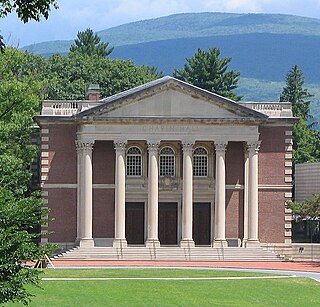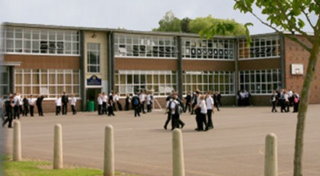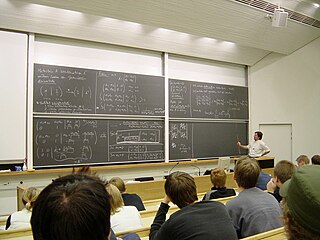This article needs additional citations for verification .(June 2020) (Learn how and when to remove this template message) |
Maliera Boys Secondary School is a secondary school in Yala, Siaya County, Kenya. [1]
This article needs additional citations for verification .(June 2020) (Learn how and when to remove this template message) |
Maliera Boys Secondary School is a secondary school in Yala, Siaya County, Kenya. [1]

A college is an educational institution or a constituent part of one. A college may be a degree-awarding tertiary educational institution, a part of a collegiate or federal university, an institution offering vocational education, or a secondary school.

Education is the process of facilitating learning, or the acquisition of knowledge, skills, values, beliefs, and habits. Educational methods include teaching, training, storytelling, discussion and directed research. Education frequently takes place under the guidance of educators, however learners can also educate themselves. Education can take place in formal or informal settings and any experience that has a formative effect on the way one thinks, feels, or acts may be considered educational. The methodology of teaching is called pedagogy.

A primary school, junior school, elementary school or grade school is a school for children from about four to eleven years old, in which they receive primary or elementary education. It can refer to both the physical structure (buildings) and the organisation. Typically it comes after preschool, and before secondary school.

A school is an educational institution designed to provide learning spaces and learning environments for the teaching of students under the direction of teachers. Most countries have systems of formal education, which is commonly compulsory. In these systems, students progress through a series of schools. The names for these schools vary by country but generally include primary school for young children and secondary school for teenagers who have completed primary education. An institution where higher education is taught, is commonly called a university college or university, but these higher education institutions are usually not compulsory.

Secondary education covers two phases on the International Standard Classification of Education scale. Level 2 or lower secondary education is considered the second and final phase of basic education, and level 3 (upper) secondary education is the stage before tertiary education. Every country aims to provide basic education, but the systems and terminology remain unique to them. Secondary education typically takes place after six years of primary education and is followed by higher education, vocational education or employment. Like primary education, in most countries secondary education is compulsory, at least until the age of 16. Children typically enter the lower secondary phase around age 11. Compulsory education sometimes extends to age 19.

Tertiary education, also referred to as third-level, third-stage or post-secondary education, is the educational level following the completion of secondary education. The World Bank, for example, defines tertiary education as including universities as well as trade schools and colleges. Higher education is taken to include undergraduate and postgraduate education, while vocational education beyond secondary education is known as further education in the United Kingdom, or included under the category of continuing education in the United States.

A student is primarily a person enrolled in a school or other educational institution and who is under learning with goals of acquiring knowledge, developing professions and achieving easy employment at a particular field. In the broader sense, a student is anyone who applies themselves to the intensive intellectual engagement with some matter necessary to master it as part of some practical affair in which such mastery is basic or decisive.
A middle school is an educational stage which exists in some countries, providing education between primary school and secondary school. The concept, regulation and classification of middle schools, as well as the ages covered, vary between, and sometimes within, countries.

Education in Canada is for the most part provided publicly, and is funded and overseen by provincial, territorial and local governments. Education is within provincial jurisdiction and the curriculum is overseen by the province. Education in Canada is generally divided into primary education, followed by secondary education and post-secondary. Within the provinces under the ministry of education, there are district school boards administering the educational programs.
State schools, called public schools in North America and many other countries, are generally primary or secondary schools mandated for or offered to all children without charge, funded in whole or in part by taxation.

A secondary school describes an institution that provides secondary education and also usually includes the building where this takes place. Some secondary schools provide both lower secondary education and upper secondary education ie levels 2 and 3 of the ISCED scale, but these can also be provided in separate schools, as in the American middle and high school system. In the UK, elite public schools typically admit pupils between 13 and 18 years of age. UK state schools accommodate pupils between 11 and 18 years of age.
The Secondary School Certificate, also called SSC or Matriculation examination, is a public examination in India, Bangladesh and Pakistan conducted by educational boards for the successful completion of the secondary education exam in these countries. Students of 10th grade/class ten can appear in these. It is equivalent to GCSE in England and first two years of high schools in United States.
A comprehensive school is a school for elementary aged or secondary aged children that does not select its intake on the basis of academic achievement or aptitude, in contrast to the selective school system where admission is restricted on the basis of selection criteria. The term is commonly used in relation to England and Wales, where comprehensive schools were introduced as state schools on an experimental basis in the 1940s and became more widespread from 1965. With the Blair educational reforms from 2003, they may be part of a local education authority or be a self governing academy or part of a multi-academy trust.
Ninth grade, freshman year, or grade 9 is the ninth post-kindergarten year of school education in some school systems. Ninth grade is often the first school year of high school in the United States, or the last year of middle/junior high school. In some countries, Grade 9 is the second year of high school. Students are usually 14–15 years old. In the United States, it is often called Freshman year. In England and Wales, the equivalent educational year is Year Ten. In Scotland, the equivalent educational year is Third Year or S3, as this is the third year of compulsory secondary schooling.
Twelfth grade, senior year, or grade 12 is the final year of secondary school in most of North America. In other regions it is also equivalently referred to as class 12 or Year 13. In most countries, students then often graduate at ages between 17 and 18. Some countries have a thirteenth grade, while other countries do not have a 12th grade/year at all. Twelfth grade is typically the last year of high school; graduation year.
Educational stages are subdivisions of formal learning, typically covering early childhood education, primary education, secondary education and tertiary education. The United Nations Educational, Scientific and Cultural Organization (UNESCO) recognizes seven levels of education in its International Standard Classification of Education system. UNESCO's International Bureau of Education maintains a database of country-specific education systems and their stages.
The Higher Secondary Certificate, also known as HSC or Intermediate or +2 examination, is a public examination taken by students of intermediate college in Bangladesh, Nepal, Pakistan and in the states of Gujarat, Tamil Nadu, Andhra Pradesh, Kerala, Telangana, Punjab, Maharashtra, West Bengal and Goa in India. In India the examination structure differs from board to board. But in most of the boards, they are subjective examinations. HSC is an equivalent to GCE A Level in England and 3rd and 4th year of high Schools in United States.
| This Kenya school-related article is a stub. You can help Wikipedia by expanding it. |